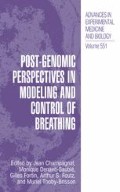Abstract
Prolyl hydroxylase is an enzyme which oxidatively modifies the proline residue of hypoxia inducible factor (HIF-lα) in the presence of oxygen in an apparently irreversible reaction. This reaction also requires labile Fe2+, 2-oxogluterate (2-OG) and ascorbic acid. Hypoxia retards this reaction and HIF-1α is accumulated. Similarly, Fe2+ chelation mimics hypoxia-like effect. Thus, the enzyme stands at the gateway between hypoxia and normoxia. The hy-droxylated HIF-1α undergoes proteasomal degradation during normoxia whereas HIF-1α, accumulated during hypoxia, binds with β-subunits to form HIF-1 which is then transcripted to various genes in the nucleus.
Access this chapter
Tax calculation will be finalised at checkout
Purchases are for personal use only
Preview
Unable to display preview. Download preview PDF.
References
Baby SM, Roy A, Mokashi A and Lahiri S. Effects of hypoxia and intracellular iron chelation on hypoxia inducible factor-1α and-1β in the rat carotid body and glomus cells. Histochemistry and Cell Biology 120: 343–352, 2003.
Bunn HF and Poyton RO. Oxygen sensing and molecular adaptation to hypoxia. Physiol Rev 76: 839–855, 1996.
Daudu PA, Roy A, Rozanov C, Mokashi A and Lahiri S. Extracellular and intracellular free iron and the carotid body responses. Respir Physiol & Neumbiol 130: 21–31, 2002.
Jewell UR, Kvietikova, Scheid A, Bauer C, Wenger RH and Gassman M. Induction of HIF1α in response to hypoxia is instantaneous. FASEB J 15: 1312–1314, 2001.
Maxwell PH and Ratcliffe PJ. Regulation of HIF-1α by oxygen. In Oxygen Sensing: Responses and Adaption to Hypoxia. Marcell Dekker, Inc. Vol. 475 Eds. Lahiri S, Semenza GL and Prabhakar NR. pp. 47–65, 2003.
Lahiri S. Historical perspectives of cellular oxygen sensing and responses to hypoxia. J Appl Physiol 88: 1467–1473, 2000.
Lahiri S, Rozanov C, Roy A, Storey B and Buerk DG. Regulation of oxygen sensing in peripheral arterial chemoreceptors. IJBCB 33: 755–774, 2001.
Ren X, Dorrington KL, Maxwell PH and Robbins PA. Effects of desferrioxamine on serum erythropoietin and ventrilatory sensitivity to hypoxia in humans. J Appl Physiol 89: 680–686, 2000.
Roy A, Buerk DG, Li J, Baby SM and Lahiri S. Intracellular iron chelation in carotid body chemotransduction. In Oxygen and Cell Symposium, Berlin, September 6–9, 2003.
Roy A, Li J, Baby SM, Mokashi A, Buerk DG, Lahiri S. Effects of iron-chelators on ion-channels and HIF-lα expression in the carotid body. Respir Physiol Neurobiol (in press).
Wang GL and Semenza GL. Characterization of hypoxia-inducible factor 1 and regulation of DNA binding activity by hypoxia. J Biol Chem 268: 21513–21518, 1993.
Agani FH, pichiule P, Chavez JC and LaManna JC. Inhibitors of mitochondrial complex I attenuates the accumulation of hypoxia-inducible factor-1 during hypoxia in HEP3B cells. Comp. Biochem. Physiol. 132:107–109, 2002.
Mulligan E, Lahiri S, Storey BT. Carotid body O2 chemoreception and mitochondrial oxidative phosphorylation. J Appl. Physiol. 250: H202–207, 1981.
Wyatt CN and Buckler KJ. The effect of mitochondrial inhibitors on membrane currents in isolated neonatal rat carotid body type I cells. J Physiol. 556: 175–191, 2004.
Author information
Authors and Affiliations
Editor information
Editors and Affiliations
Rights and permissions
Copyright information
© 2004 Kluwer Academic/Plenum Publishers, New York
About this paper
Cite this paper
Lahiri, S., Roy, A., Li, J., Baby, S.M., Mokashi, A., Di Giulio, C. (2004). Role of Fe2+ in Oxygen Sensing in the Carotid Body. In: Champagnat, J., Denavit-Saubié, M., Fortin, G., Foutz, A.S., Thoby-Brisson, M. (eds) Post-Genomic Perspectives in Modeling and Control of Breathing. Advances in Experimental Medicine and Biology, vol 551. Springer, Boston, MA. https://doi.org/10.1007/0-387-27023-X_10
Download citation
DOI: https://doi.org/10.1007/0-387-27023-X_10
Publisher Name: Springer, Boston, MA
Print ISBN: 978-0-306-48507-7
Online ISBN: 978-0-387-27023-4
eBook Packages: Biomedical and Life SciencesBiomedical and Life Sciences (R0)

